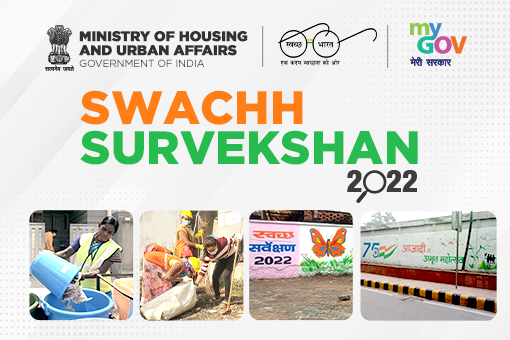Swachh Survekshan 2022

Copyright infringement is not intended
Context: The Union Government launched field assessment of Swachh Survekshan 2022.
Details:
- The field assessment for Swachh Survekshan was launched on 1st March 2022 by the Ministry of Housing and Urban Affairs (MoHUA).
- Launched with ‘People First’ as its driving philosophy, Swachh Survekshan 2022 is targeted towards capturing the initiatives of cities for the overall welfare and well-being of Sanitation workers.
- This year another new indicator ‘Swachh Technology Challenge’ has been added.
- To expand the Survekshan footprint, district rankings have been introduced for the first time.
- The scope of the survey has been expanded to now cover 100% wards, as compared to 40% in previous years.
Swachh Survekshan:
- Swachh Survekshan was initiated by the Ministry of Housing and Urban Affairs in 2016 as a competitive framework to encourage cities to improve the status of urban sanitation.
- Swachh Survekshans Conducted under the Swachh Bharat Mission (Urban).
- It has promoted a spirit of healthy competition among cities and towns of India.
- The Primary goal of Swachh Survekshans is to encourage large scale citizen participation and create awareness amongst all sections of society about the importance of working together towards making towns and cities better places to reside in.
- The performance of each city is evaluated on six parameters:
- Municipal solid waste, sweeping, collection and transportation.
- Municipal solid waste, processing, and disposal of solid waste.
- Open defecation free and toilets.
- Capacity building and e-Learning.
- Provision of public toilets and community toilets.
- Information, education and communication, and behavior change.
Swachh Bharat Mission:
- Swachh Bharat Mission (SBM) is a country-wide campaign initiated by the Government of India in 2014 to eliminate open defecation and improve solid waste management.
- It is a restructured version of the Nirmal Bharat Abhiyan launched in 2009.
- Phase 1 of the Swachh Bharat Mission lasted till October 2019.
- Phase 2 is being implemented between 2020–21 and 2024–25.
- The mission aimed to achieve an "open-defecation free" (ODF) India by 2 October 2019, the 150th anniversary of the birth of Mahatma Gandhi through construction of toilets.
- The objectives of the first phase of the mission:
- Eradication of manual scavenging
- Generating awareness and bringing about a behavior change regarding sanitation practices
- Building capacity at the local level.
- The second phase of the mission aims to sustain the open defecation free status and improve the management of solid and liquid waste, while also working to improve the lives of sanitation workers.
- Under the scheme, the Government provides subsidies for constructing toilets, waste management structures, and awareness campaigns to bring behavior change.
- The campaign is financed by the Government of India and state governments.
- The mission is split into two: Rural and Urban.
- In rural areas "SBM - Gramin" is financed and monitored through the Ministry of Jal Shakti.
- In Urban areas "SBM - urban" is overseen by the Ministry of Housing and Urban Affairs.
Present Status:
- According to the dashboards maintained by ministries, more than 100 million individual household level toilets have been constructed in rural areas, and 6 million household toilets in urban areas.
- Nearly 6 million community and public toilets have also been constructed in the urban areas.
- More than 4,200 cities and more than 600,000 villages across the country have declared themselves open defecation free (ODF).
- More than 81.5 thousand wards in urban areas now have 100% door to door collection of solid waste and nearly 65 thousand wards practice 100% segregation of waste at source.
- According to UNICEF, the number of people without a toilet has been reduced from 550 million to 50 million.
- The World Bank reports that 96% of Indians who have a toilet use it.
- A study concluded that the construction of toilets under the program led to a reduction in incidence of sexual assault against women.



1.png)
